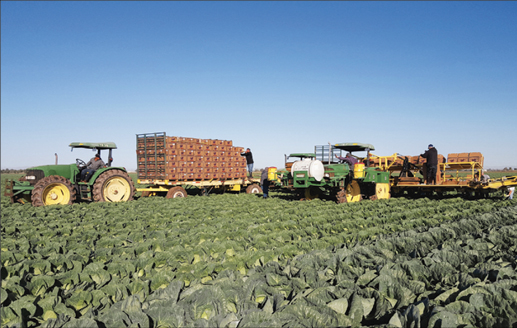Mar 17, 2022Steady markets, growing conditions favor California cabbage
Irish eyes are smiling upon California cabbage growers in time for St. Patrick’s Day.
“So far, everything’s looking good as far as all the varieties,” said Frankie Oliver, field supervisor at Pacific Fresh Produce in Oxnard. “It’s been good quality, and everything’s coming along just right.”
In Imperial County, Scott Howington started planting organic cabbage transplants in early September in his fields near Holtville and El Centro. “Quality-wise, it’s been excellent – probably one of our better (seasons),” Howington said.
In 2019, the most recent year with statewide figures available, California farmers planted 14,800 acres of cabbage and harvested 14,500, according to the California Department of Food and Agriculture (CDFA). Yield was 410 tons of cabbage per acre, worth just north of $212.2 million.
Cabbage acreage in the state was relatively steady throughout the 2010s, according to CDFA, trending slightly downward from 13,700 planted acres in 2010 before growing to a high of 14,900 acres in 2017.
Oliver has red, green and savoy cabbage in his Ventura County fields.
“The stuff that we’re in right now was planted in early November; that’s just coming off right now,” Oliver said. “The red and savoy take a little bit longer, but the green is probably a couple weeks earlier as far as harvest.”
Oliver’s biggest headache so far is the diamondback moth, which has been vexing growers in Ventura County and elsewhere.
“In larval form, it’s like a worm,” Oliver said. “It just goes into the head and damages the crop. Sometimes, it’s unharvestable. They have to spray a little bit more, and costs go up because of that. There was major pressure last summer.” The pest is dealt with through additional sprays or bug vacuums, he said.
In the Imperial Valley, the winter vegetable season is nearing its conclusion.
“It’s that time of year where it’s getting warm, a lot of wind, so that’s always hard to deal with,” Howington said, explaining, it’s “pretty much a normal ending for the winter vegetable season down here.”
Most of the desert vegetable crops will finish within the next couple of weeks, Howington said. Cabbage could be extended another week or more depending on quality and availability.
“If they’re shipping it out of Watsonville and they have product up there, then obviously there’s no reason to truck it from here,” Howington said. “If they don’t have it, and we have the quality, we’ll extend our season down here.”
Oliver said markets have mostly bounced back from the onset of COVID restrictions in March 2020, when “everything shut down, as well as our business, and nobody bought anything,” he said.
“After that, after a couple weeks or a couple months, it bounced back a little bit,” Oliver said, adding that current markets are steady. “It’s remained up and down, just almost normal, and as far as supplies, it’s remained steady as well.”
As of March 11, round green cabbage from the Imperial and Coachella valleys was selling for $14.35 to $18.55 for a 50-pound carton, according to the U.S. Department of Agriculture Agricultural Marketing Service. USDA lumped Imperial and Coachella valley cabbage with product from western Arizona and Mexico.
Of the markets, Howington said that “just from the movement, it’s been a typical year. The harvest has gone pretty smoothly as far as being able to keep up with the fields and not getting behind.”
This is true even though labor has “always been a challenge,” he noted, “especially paying for it—it’s more and more expensive, like everything else.”
“Whether you’re speaking cabbage or any other vegetable, you’re at the mercy of so many different variables—(and caught) between market conditions, demand, labor cost and availability, fuel cost” and material expenses, including for fertilizer, tractor parts and tires, he said.
“Sometimes we’re forced to spend money that we shouldn’t have to spend just to make sure we have something when we need it,” Howington said. “I’m going to call it a complicated year in that respect.”
— Kevin Hecteman, California Farm Bureau















